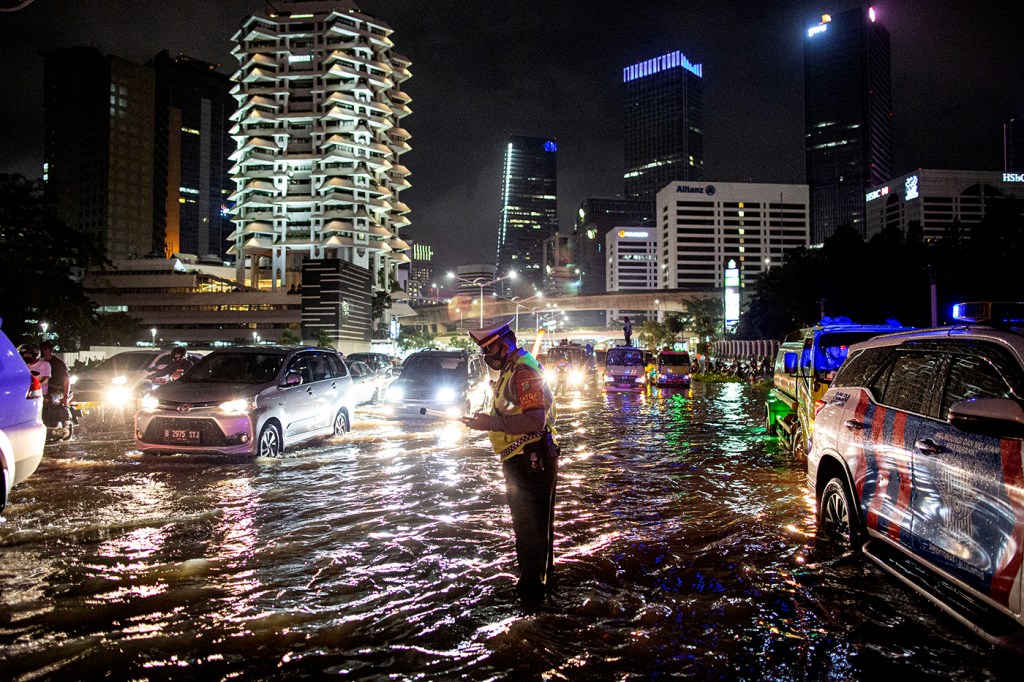Indonesia is building a new capital. Will it be a model amid climate change?

Jakarta, the Indonesia capital city of 30 million people, is sinking.
In the absence of effective remedies—including plans for a great sea wall that have been dismissed as ineffective—Indonesia President Joko Widodo has committed to building from scratch a replacement capital city 800 miles away on the large island of Borneo.
Will Indonesia’s mission to devise and construct a new green metropolis serve as a model for other coastal cities in the era of climate change?
Joko hopes by August 2024 to open the new capital, called Nusantara, around a base of government buildings powered largely by renewable energy.
“I think it will act as a pilot project,” says Gavin Shatkin, professor of public policy and architecture at Northeastern. “There are efforts afoot across Asia and elsewhere to develop more climate-friendly approaches to urban development.”
Initial plans to build a great seawall around Jakarta have been abandoned in part because climate change has not been the main driver of the city’s problems. As the city has grown, residents (including businesses) have extracted fresh water from private wells which—along with unregulated building—have caused the city to sink, says Shatkin, an urban planner who has researched Jakarta’s issues from the perspective of land rights.
Jakarta has been beset with flooding as well as wastewater issues.
“It’s a matter of total water management,” says Auroop Ganguly, a Northeastern distinguished professor of civil and environmental engineering who led a Northeastern Dialogue of Civilizations tour of students to Indonesia in 2017. “The river starts up in the hills and makes its way down to Jakarta.”
Though climate change “is probably one of the smaller factors” of Jakarta’s ongoing misery, says Ganguly, the creation of a new capital could serve as an example for other countries—especially those in emerging economies.
“I’m very hopeful about Indonesia,” says Ganguly, noting that plans are being laid for a progressive transit system that emphasizes public transportation and bicycling.
The nascent project has raised far more questions than can be answered for Indonesia, a nation of 280 million people spread across more than 17,000 islands. The first migration will be focused on moving government operations to Nusantara. But what will become of the 30 million Jakarta residents as well as the businesses that drive the Indonesian economy?
“The government is saying that it is going to invest substantial resources in mitigating flooding in Jakarta” even as it builds the new capital, Shatkin says. But he notes that even if the development meets its ambitious aspirations of more than 1 million residents, there will still be a vast population left in Jakarta.
“There are a lot of good reasons to build a new capital—one is to make sure that government functions don’t get disrupted by the flooding,” Shatkin says. “But you’re still going to have a major part of the economy and a huge part of the population that are subject to these hazards.”
The Nusantara project is part of Indonesia’s commitment to reducing carbon emissions by as much as 43% by 2030, Mohammed Ali Berawi, deputy of Green and Digital Transformation of IKN-Nusantara, writes in an email to NGN.
“Indonesia has recognized the importance of economically valuing carbon emission reduction as an ecosystem service,” writes Berawi, adding that natural corridors to protect wildlife are being maintained as land is cleared for the new capital.
Jerome Hajjar, CDM Smith Professor and chair of civil and environmental engineering at Northeastern, wonders about the sourcing of materials that are used to build the new city.
“It has a huge impact on the sustainability metrics,” says Hajjar, noting that U.S. steel mills are increasingly reliant on renewable energy.
Shatkin notes that 80% of the Nusantara financing will come from the private sector, which could force environmental compromises to be made in order to deliver a return on investments. With Joko’s second and final term ending next year, a change in presidential leadership could alter priorities.
“Egypt is building a [new] capital city and I’d be hard-pressed to say that sustainability is at the top of their list,” Hajjar says. “They’re not making a walking city and I’m not quite sure what’s motivating them.
“Indonesia appears to have better policies in terms of what they’re trying to do,” Hajjar says. “I applaud them for recognizing that they’re having a serious civil engineering issue in their city. Instead of doing nothing about it, they’re doing something big to address it.”
Shatkin says Indonesia is bound to face obstacles while pioneering a new way forward in the era of climate change.
“We can see from history that when new planned capitals are built, they do not really displace the existing economic centers,” says Shatkin, citing examples that include the 1960 creation of Brasilia and the United States’ capital move from New York to Philadelphia in 1790 before settling a decade later in Washington.
Ganguly led a Dialogue of Civilizations tour last year to Tanzania that added to his perspective on Nusantara.
“Tanzania has shifted its capital from Dar es Salaam to a place called Dodoma, which is inland,” Ganguly says. “The government offices are in Dodoma, but if you think of which city is most prominent, it is Dar es Salaam, where many of the businesses are still located.
“We’re thinking of Nusantara as hopefully a role model for cities around the world,” Ganguly adds. “But it will take time.”
Ian Thomsen is a Northeastern Global News reporter. Email him at i.thomsen@northeastern.edu. Follow him on Twitter @IanatNU.






